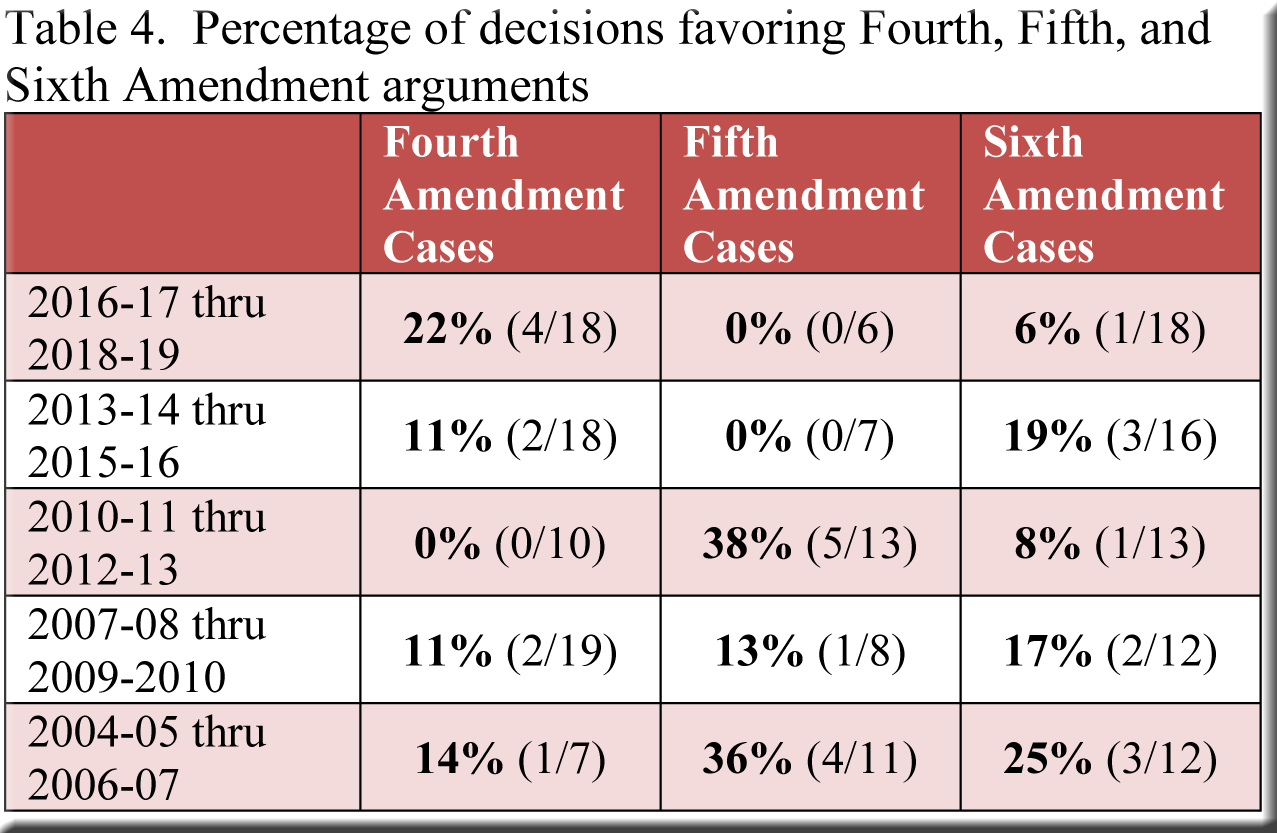The Fifth Amendment provides some of the best-known protections promised to Americans by the US Constitution. It prohibits (1) prosecution for serious crimes without a prior, legal indictment by a grand jury; (2) repeated prosecution for the same offense (“double jeopardy”); (3) involuntary self-incrimination—being forced to testify or give evidence against one’s self; and (4) deprivation of life, liberty, or property without “due process of law” or “just compensation.” SCOWstats has previously examined the fate of other constitutional principles at the Wisconsin Supreme Court; today we turn our attention to the Fifth Amendment.
Individual justices
Over the past fifteen terms (2004-05 through 2018-19), the court favored Fifth Amendment arguments in 22% of the cases (10/45) in which these arguments were presented.[1] Table 1 displays the percentages for each justice.
Criminal cases and takings claims
Most of 45 cases under consideration involved people charged with crimes, but eight did not. This subset featured “takings claims”—civil cases in which people complained that they had been deprived of property without “just compensation.” Most often, litigants asserted that (1) a government agency had acquired some (or all) of their property—via eminent domain proceedings, for instance—but failed to compensate them fairly; or (2) a nearby construction project had reduced the value of their property unjustly. When our 45 cases are divided into “criminal” and “takings claim” categories, we find that the justices were twice as likely to accept Fifth Amendment arguments in the latter category (38%) as they did in criminal cases (19%).
Consequently, although the disparities between the justices are considerable in Table 1, they are even more striking when we separate criminal cases from those involving takings claims, as shown in Table 2. Few could be surprised to discover that liberal justices were far more sympathetic than their conservative colleagues to Fifth Amendment arguments in criminal cases, while conservatives deemed the Fifth Amendment much more robust on behalf of civil litigants with property claims against the government.[2]
More on the Butler-Gableman transition
A post last year titled “The Butler-Gableman Divide” noted the substantial change in supreme court decisions after the replacement of Justice Butler by Justice Gableman in 2008. As examples, the post supplied figures on the court’s rulings in criminal and insurance cases, as well as cases focused on the Fourth and Sixth Amendments. Now, the sample can highlight Fifth Amendment decisions too, which shifted every bit as abruptly as did decisions in the other categories following the arrival of Justice Gableman. The difference is clear for Fifth Amendment cases taken together, and it becomes still more vivid once these cases are subdivided, as demonstrated in Table 3.
The fading Fifth
Finally, it’s interesting to compare trends involving the Fourth, Fifth, and Sixth Amendments. Other posts have found that the justices have grown chillier of late to Sixth Amendment arguments but better-disposed toward those invoking the Fourth Amendment. To see this over the 15 terms examined here, refer to Table 4, which consolidates the data into three-term intervals.[3] During the earliest interval (covering 2004-05 through 2006-07), the court accepted 25% of Sixth Amendment arguments and only 14% of Fourth Amendment arguments. However, by the most recent interval, the figure had risen to 22% for the Fourth Amendment, while plummeting to 6% for the Sixth Amendment. Precipitous as this drop was for the Sixth Amendment, the plunge evident in the Fifth Amendment column eclipsed it. In the earliest interval, Fifth Amendment arguments had a considerably better chance of prevailing than did their counterparts in both of the other columns, but, in the last interval—indeed, the last two intervals—Fifth Amendment assertions experienced no success at all.
[1] We are considering cases with central arguments pertaining to the Fifth Amendment (and/or equivalent provisions in the Wisconsin Constitution). If a litigant made a Fifth Amendment claim, but the justices decided the matter on other grounds, I omitted the case. Disciplinary cases involving lawyers are excluded as well.
I also omitted a handful of “gray-area” cases. For instance, in State v. Alexander (2013AP843-CR), the parties agreed that compelled, incriminating statements to Alexander’s probation agent should not have been included in the presentence investigation consulted by the circuit court. However, in reversing the court of appeals, the justices ruled that the circuit court did not rely on these statements when it sentenced Alexander, and thus he was not prejudiced when his attorney failed to object to the statements.
[2] Of course, percentages are unreliable for justices who cast only one vote in the “Takings Claims” category.
[3] The table includes civil and criminal cases.




Speak Your Mind